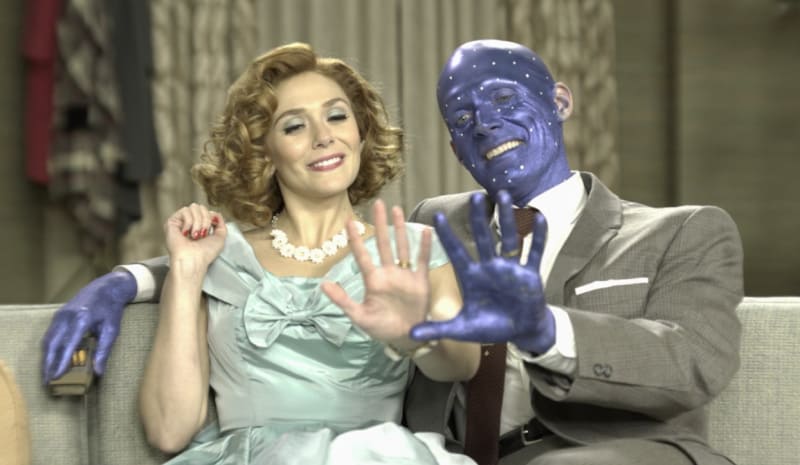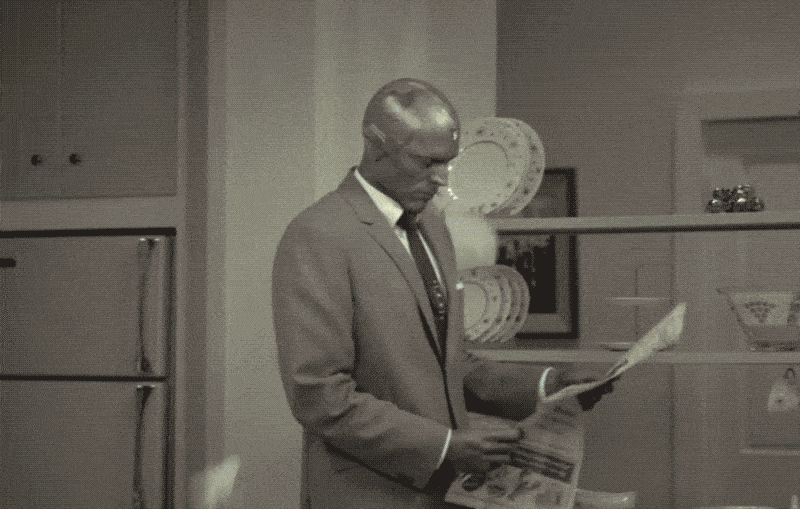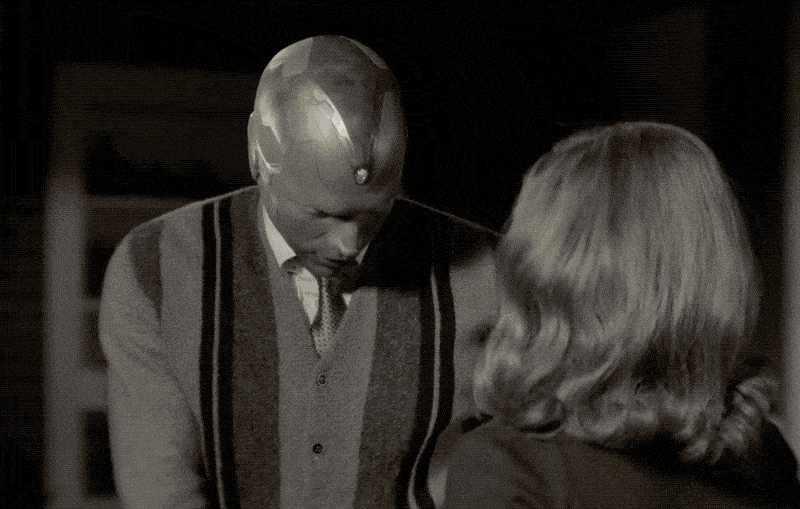
Welcome to World Builders, our ongoing series of conversations with the most productive and thoughtful behind-the-scenes craftspeople in the industry. In this entry, Brad Gullickson chats with Tara DeMarco about WandaVision’s hidden and not-so-hidden visual effects.
Uh, who the heck is that? The thought rippled through the Twitterverse the moment Disney+ launched their Assembled premiere episode on the making of WandaVision. In peeling back the curtain, they revealed Paul Bettany‘s on-set appearance as Vision, and the shock was unnerving for many. There are several steps to bringing the Synthezoid Avenger to life. Most monumental of which is replacing Bettany’s very-real human face with a total digital construct. Yes, Wanda’s robo-lover is a visual effects miracle not far removed from War for the Planet of the Apes‘ Caesar or Avatar‘s Na’vi.
While WandaVision contains obvious VFX like the Hex barrier and the witch-on-witch fireball showdown, there are just as many hidden touches spread throughout the series. In replicating various sitcom aesthetics, from the 1950s to the 2000s, WandaVision slyly and slowly flexes its blockbuster muscles. The show looks like a billion bucks and nearly cost as much.
Marvel Studios promised they were bringing the big screen experience to the small screen, and it fell on Visual Effects Supervisor Tara DeMarco to deliver. During pre-production, she spent a few months devouring the movies in the Marvel Cinematic Universe, experimenting and fine-tuning her methods. When she and her team snipped segments from Captain America: Civil War and applied them to WandaVision‘s desired Dick Van Dyke sheen, a few problems arose.
“We tested with footage from Civil War just to see what the red looked like in black-and-white,” explains DeMarco. “Ultimately, we determined that it was too dark and you couldn’t really read him. Once we had cameras and lights and lenses and everything, we did [our testing] as part of the normal hair and makeup and lens testing. We did a few different shades of blue. It’s a little stressful because it’s a beloved character, and you want to make sure he looks right. Beyond that, it was okay.”
During television production in the ’50s and ’60s, actresses would apply blue lipstick to their lips to appear red within the black-and-white frame. The same logic was used for translating Vision into these early sitcom eras. Color, however, was not the only obstacle. Vision’s new overly comedic demeanor, and the facial elasticity that comes with it, required additional solutions.
“The interesting challenge for Vision in the sitcoms,” DeMarco continues, “is that he makes many more faces than he did as a robot in the MCU. So, we spoke with the vendors that would be executing Vision, about testing and making sure we liked the way his skin panels looked while he was making all his different funny faces. Once we were into filming, we did a few selects and sent them along even before we were cutting. We made sure that Matt Shakman, our director, liked them.”
With a thumbs up from Shakman, approval was then moved to the studio. Once everyone felt like the black-and-white Vision looked like the regular MCU Vision, DeMarco could update her rig, a.k.a. the character’s digital skeleton. Going forward, capturing Paul Bettany’s on-set micro-facial movements presented no issues.

Every decision that was made extends from the script. Once hired, diving into the story was DeMarco’s first task. She’s like the rest of us, caught up in the adventure and where it’s going to drop these characters. She’s invested and wants the best for them.
“I try very hard not to put on my Visual Effects Supervisor hat in the first read,” says DeMarco. “I just read it. Read for story, read for character and for plot and for vibe. I don’t want to immediately go down the rabbit hole of, ‘This we’ll have to film in this many pieces and make that part CG.’ The first read is always just for story. Then, on the second read, I’ll break down the scenes and figure out what pieces we can capture for real. Because we want to capture as many pieces for real as we can. And then, what pieces need CG enhancement or what pieces need to be full CG.”
As DeMarco works her way through the scripts, certain set-pieces set off her spider-sense. You know, the sci-fi brawls and bright beams of light in the sky. Their difficulty level is evident on the page, and they become the sequences she focuses on first.
“The scenes that we knew would be hard would be Vision in the home and the town being created in black-and-white,” she says. “Wanda saying goodbye to Vision and taking the Hex down. The scenes where Vision gets torn apart by the Hex. The whole pop-up base turning into a circus. Those read as complicated, and we knew that they would be hard.”

The fun occurs amongst the surprises. The sections that feel like problems you’ve already tackled and solved in the past. Assumptions are made, but then on the day, problems erupt, and answers must come quickly.
“What ended up being a challenge in a way [we didn’t expect] was the kid’s super-speed,” says DeMarco. “Part of why it didn’t appear a challenge in the first read was that it was already established. It was established in Age of Ultron. We knew we wanted it to look like Pietro’s super-speed. We were like, ‘Oh yeah, we know what that looks like, that’s fine.” But in actuality, the kids hold hands at the beginning, and there’s a costume change, and those scenes are just a little more complicated than we all first imagined. We got it, but the first few were a little tricky, and we ended up picking a few additional pieces up on green screen or whatever to help support the visual.”
In the case of Quicksilver, DeMarco not only had his MCU appearance in Age of Ultron to consult, but there were also the X-Men films that originated with 20th Century Fox to consider. With Evan Peters as Uncle Pete in play, Marvel Studios had to contemplate other visual effects possibilities.
“We all love that [X-Men: Days of Future Past] Michael Fassbender/Quicksilver kitchen scene,” she says. “But I’ve done a number of other frozen moment shots in my life. We had talked about potentially doing a frozen moment here, but — and it didn’t really have anything to do with Fox. It was more like, is this a cool, beautiful effect that drives the story? Which is ultimately where we go with everything.”
DeMarco doesn’t spend much time online. She’s been made aware of certain reactions to the show, but she’d rather not fall down that black hole. It delights her knowing that folks are watching Assembled and having their minds blown by Paul Bettany’s big blue head.
“I have seen one incredibly hilarious fake Funko Pop of Blue Vision with ears out,” she says. “It made me really smile, and I sent it to our entire VFX team.”
These days, there is no sincerer form of flattery than a custom Funko. DeMarco’s work on WandaVision brought both titular characters into new emotional realms. In bouncing through various sitcoms, Wanda and Vision were unchained by their previous genre and free to convey themselves radically. For Vision to crack more than a smile but a full spectrum of Bettany expressions, Demarco solved a mess load of math.
Related Topics: Marvel Studios, visual effects, WandaVision, World Builders

